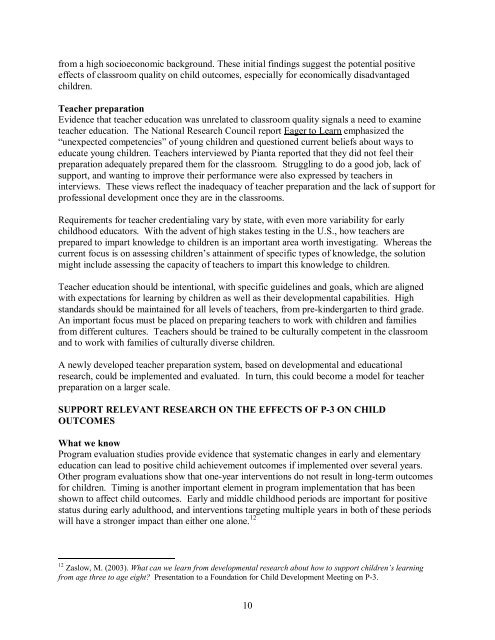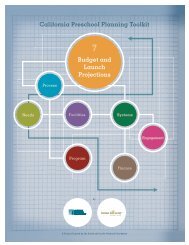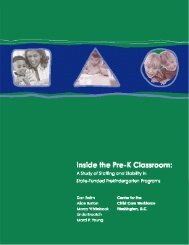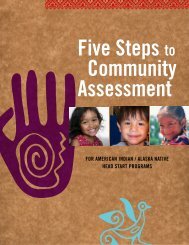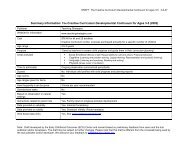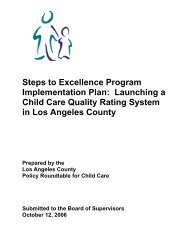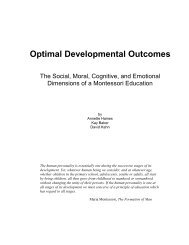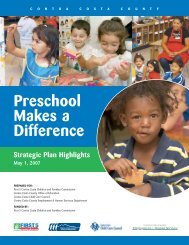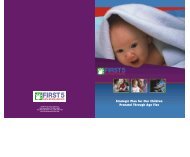Mapping the P-3 Continuum - Foundation for Child Development
Mapping the P-3 Continuum - Foundation for Child Development
Mapping the P-3 Continuum - Foundation for Child Development
Create successful ePaper yourself
Turn your PDF publications into a flip-book with our unique Google optimized e-Paper software.
from a high socioeconomic background. These initial findings suggest <strong>the</strong> potential positiveeffects of classroom quality on child outcomes, especially <strong>for</strong> economically disadvantagedchildren.Teacher preparationEvidence that teacher education was unrelated to classroom quality signals a need to examineteacher education. The National Research Council report Eager to Learn emphasized <strong>the</strong>“unexpected competencies” of young children and questioned current beliefs about ways toeducate young children. Teachers interviewed by Pianta reported that <strong>the</strong>y did not feel <strong>the</strong>irpreparation adequately prepared <strong>the</strong>m <strong>for</strong> <strong>the</strong> classroom. Struggling to do a good job, lack ofsupport, and wanting to improve <strong>the</strong>ir per<strong>for</strong>mance were also expressed by teachers ininterviews. These views reflect <strong>the</strong> inadequacy of teacher preparation and <strong>the</strong> lack of support <strong>for</strong>professional development once <strong>the</strong>y are in <strong>the</strong> classrooms.Requirements <strong>for</strong> teacher credentialing vary by state, with even more variability <strong>for</strong> earlychildhood educators. With <strong>the</strong> advent of high stakes testing in <strong>the</strong> U.S., how teachers areprepared to impart knowledge to children is an important area worth investigating. Whereas <strong>the</strong>current focus is on assessing children’s attainment of specific types of knowledge, <strong>the</strong> solutionmight include assessing <strong>the</strong> capacity of teachers to impart this knowledge to children.Teacher education should be intentional, with specific guidelines and goals, which are alignedwith expectations <strong>for</strong> learning by children as well as <strong>the</strong>ir developmental capabilities. Highstandards should be maintained <strong>for</strong> all levels of teachers, from pre-kindergarten to third grade.An important focus must be placed on preparing teachers to work with children and familiesfrom different cultures. Teachers should be trained to be culturally competent in <strong>the</strong> classroomand to work with families of culturally diverse children.A newly developed teacher preparation system, based on developmental and educationalresearch, could be implemented and evaluated. In turn, this could become a model <strong>for</strong> teacherpreparation on a larger scale.SUPPORT RELEVANT RESEARCH ON THE EFFECTS OF P-3 ON CHILDOUTCOMESWhat we knowProgram evaluation studies provide evidence that systematic changes in early and elementaryeducation can lead to positive child achievement outcomes if implemented over several years.O<strong>the</strong>r program evaluations show that one-year interventions do not result in long-term outcomes<strong>for</strong> children. Timing is ano<strong>the</strong>r important element in program implementation that has beenshown to affect child outcomes. Early and middle childhood periods are important <strong>for</strong> positivestatus during early adulthood, and interventions targeting multiple years in both of <strong>the</strong>se periodswill have a stronger impact than ei<strong>the</strong>r one alone. 1212 Zaslow, M. (2003). What can we learn from developmental research about how to support children’s learningfrom age three to age eight? Presentation to a <strong>Foundation</strong> <strong>for</strong> <strong>Child</strong> <strong>Development</strong> Meeting on P-3.10


